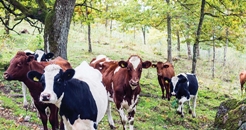 Silvopasture
Silvopasture
From an article by Reasons to be Cheerful
Silvopasture, the ancient practice of integrating trees and pastureland, is making a comeback as a way for farms to improve animal health while benefiting the climate.
On a clear morning in April, after milking his seven cows, Tim Sauder looked over the pasture where he had just turned the animals out to graze. Like many dairy farms, Sauder’s fields swayed with a variety of greenery: chicory, alfalfa and clover. But they were also full of something typically missing on an agricultural landscape — trees. Thousands of them.
Between 2019 and 2021, Tim planted 3,500 trees at Fiddle Creek Dairy, a 55-acre family farm in Lancaster County, Pennsylvania, where he and his wife raise cows to produce yogurt, cheese and beef.
Tim said planting trees has always been a priority; before he filled his pastures with them, the farm was home to a small fruit orchard as well as riparian buffers — trees planted along the creek to prevent erosion and safeguard water quality. But the trees that his cattle now graze beneath represent a fundamental shift in his operation.
They are practising silvopasture, the ancient practice of raising animals and growing trees and pasture on the same piece of land (silva is forest in Latin). In a silvopasture setup, farmers carefully manage each element to benefit the other — relying on manure to fertilize trees, for example, or fallen fruit to feed the livestock — resulting in a system that’s greater than the sum of its parts.
In Tim’s pastures, each tree has multiple benefits. Mulberry leaves have more protein than alfalfa, and the seed pods that fall off the honey locust every autumn are packed with sugar; those trees were chosen to supplement the animals’ diet. Sauder chose other tree species with leafy canopies to protect his herd’s health. “Come August, there will be shade here when the cows need it.”
Farmers are noticing the hotter temperatures. Their cattle are uncomfortable, they’re not putting on weight. A 2022 study from Cornell University predicted that losses of cattle herds due to heat stress will total $15 to $40 billion a year by the end of the century. Shade is one way silvopasture cuts down on costs, but there are others. Some poultry farmers use the method to shield their flocks from birds of prey. Vineyards and Christmas tree farms are increasingly turning to grazing animals to mow and control weeds.
But a silvopasture system can do more than simply save farmers money. Project Drawdown, a nonprofit that analyzes climate solutions, ranks silvopasture as the 11th most effective strategy for combating climate change — well ahead of solar panels, recycling and electric cars — finding that pastures with trees sequester five to 10 times as much carbon as similarly sized but treeless pastures. The perennial roots of a silvopasture system can also help stabilize the soil, preventing erosion as well as the flooding that’s becoming more common with heavier rains. Additionally, a well-managed silvopasture operation can reduce wildfire loads — thanks to carefully spaced and pruned trees as well as grazing animals that control the shrubby understory — and increase biodiversity. What’s more, when livestock get to eat the forage that’s right in front of them, the farming equipment and trucks typically used to get food to feedlots can stay in park.
Funding remains a major barrier to farmers hoping to pursue silvopasture as the trees have to be bought and planted - a lot of cost and work upfront.
Read the full article here.
Retweet about this article:
From an article by Reasons to be Cheerful, 16/08/2023